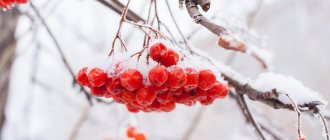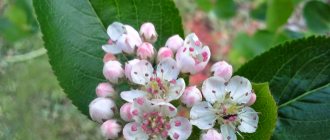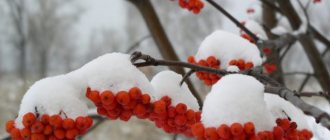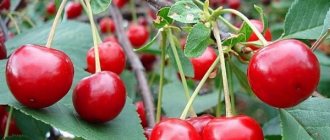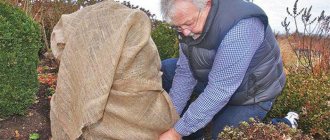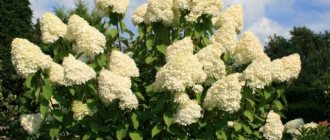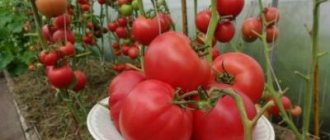Rowan Ruby: description and characteristics of the variety
Rowan Ruby: photo of variety
Ruby rowan is not a very tall tree, rarely reaching three meters, as a rule, its height is two to two and a half meters. The tree has a drooping crown, finely serrated leaves of light green color and light brown bark. Small rowan flowers, like those of other varieties, are collected in corymbose-type inflorescences and have a white-pink color. The tree blooms in late spring or early summer - the timing may vary depending on the climate of the region in which the rowan grows. And thanks to its frost resistance, this tree can grow and bear fruit even in the coldest areas of our country. Ruby rowan berries are round, slightly flattened, rich wine-ruby color with bright yellow flesh. Their taste is both sour and sweet, with a slight tartness. The berries are suitable for preparing alcoholic drinks, as well as making juices and canning. Harvest usually occurs at the end of September or beginning of October.
Ruby rowan belongs to cross-pollinated varieties, so to get a harvest you will have to plant at least one more rowan, but of a different variety. If there is very little space on your summer cottage, then you can graft a cutting of a different variety onto your tree.
How to understand rowan trees?
Our common, ubiquitous red rowan belongs to the large botanical genus Sorbus . In turn, almost all modern cultivated varieties trace their ancestry from this plant.
More precisely, from its two varieties-varieties: Moravian (Central Europe) and Nevezhinskaya (Eastern Europe).
Moravian rowan was discovered in the Czech Republic in the 19th century and was named after the region where it was found - Moravia. Its sweet fruits, 1 cm in diameter, made this variety interesting for breeders.
From it came, for example, the varieties Edulis, Bissneri and Concentra.
Almost all modern cultivated varieties trace their ancestry to two varieties of mountain ash - Moravian and Nevezhinsky.
The Nevezhinsky clone was also found by accident - in a forest near the village of Nevezhino, Vladimir region. The sweet, completely without bitterness fruits captivated the local peasants, who quickly figured out how to grow this rowan and sell the seedlings to their neighbors.
And this also happened in the 19th century. So almost instantly, in two ends of Europe, nature gave man a sweet rowan instead of a bitter one.
Sometimes Nevezhin rowan is called “Nezhinskaya” . Everyone was confused by the wine merchant Fyodor Smirnov, who in the old days sold tincture made from its fruits. Not wanting to reveal the secrets of the recipe to his competitors, he deliberately dropped one syllable and named his product “Nezhinskaya”.
Ivan Vladimirovich Michurin was very interested in breeding varietal rowan trees. Many of the varieties he created today have either been lost, or have been pollinated and lost their original characteristics, or are stored only in scientific collections. But those that have survived often become the basis for modern breeding work.
Rowan Ruby: pros and cons
Like any plant, the Rubinovaya rowan variety boasts its strengths, but in addition it also has disadvantages. The undoubted advantages can be considered:
- The beauty of the plant. The light green foliage combined with the rich color of the berries looks very beautiful.
- Dessert taste of berries, which was obtained by crossing rowan and pear.
- Frost resistance, which allows you to grow the tree in any climate.
To be fair, it should be noted that the berries of the Rubinovaya rowan variety still have some bitterness - this can be considered a disadvantage of this variety. Another disadvantage is that rowan cannot be grown in lowlands and wetlands.
Bead
The variety was created by Candidate of Agricultural Sciences Tatyana Kirillovna Poplavskaya . Fanatically devoted to science, in the 70s of the 20th century she was actively involved in the search and restoration of lost Michurin varieties of mountain ash.
Characteristics and description of the variety:
- Plant of moderate growth, 3 meters high. The shoots are gray-brown, straight. According to various sources, it begins to bear fruit at the 3rd or 5th year of life.
- The leaves are light green, serrated.
- The inflorescences are large, with white flowers.
- The fruits have a regular round shape, with red skin, weighing 1.2-1.9 grams. The flesh is cream-colored, with a hint of cranberry flavor, but without strong acid. The purpose is universal. They ripen early, by the end of August.
Particularly valuable advantages of the variety are its high resistance to extreme frosts, drought, and diseases. Productivity is high.
The rowan variety Businka is not astringent and is highly resistant to extreme frost, drought, and disease.
| Chemical composition of fruits | |
| Sugar | 10% |
| Organic acids | 2,2% |
| Vitamin C | 67 mg/100 g |
| Carotene | 9 mg/100 g |
| Dry matter | 25% |
Rowan Rubinovaya: planting varieties
Rowan Ruby: photo of variety
Like other trees, Ruby rowan can be planted in spring or autumn. Since the tree must take root before frost, the timing of planting depends entirely on the climatic characteristics of the region, and in cold areas with short summers, autumn planting is not recommended, while in the south of the country trees can be planted in early November. If you realize that you have delayed planting in the fall and are not sure that the plant will have time to take root before the onset of cold weather, then you can save the seedlings until spring. This can be done in different ways.
- Firstly, you can store the plants in the basement, if you have one. To do this, the roots of the rowan must be placed in a container with moistened peat (or sawdust, or sand) and ensure that it does not dry out. The air temperature should not fall below zero and rise above +7...+9 degrees, air humidity should be very high.
- Secondly, the seedling can be buried. To do this, you will need to dig a hole and place the mountain ash in it at an angle of forty-five degrees, and then fill it with sand and peat mixed in equal parts.
- And the third method is called “snowmaking”. The planting material must be wrapped in cloth and buried in the snow, and throughout the winter be sure to ensure that the snowdrift over the seedling does not decrease.
Before planting, dig the soil deeply and remove all weeds. When choosing a place for Rubinova rowan, remember that the tree needs space and sunlight; it should not be in the shadow of other trees, or, conversely, shade less tall plants.
The planting hole for Rubinova rowan should be 70-80 cm in diameter and approximately 60-70 cm deep - these are approximate dimensions; in fact, you need to start from the size of the root system of your seedling. Place a drainage layer at the bottom of the hole, and then pour in a specially prepared nutrient mixture consisting of garden soil, compost, and rotted manure. Add to this some phosphate fertilizers and a glass of ash. The planting hole should be one-third filled with such a mixture, then the seedling should be placed on it, straightening the roots if necessary, cover everything with soil, compact it a little and water it, using 10-15 liters of water.
Rowan Ruby: variety care
If you planted Ruby rowan in the autumn, then additional watering will most likely not be needed; there is enough rainfall in the fall. But when planting in spring, you need to water the rowan regularly, so rooting will happen much faster.
Adult mountain ash of the Rubinovaya variety will require watering only in the absence of precipitation. As a rule, the tree is watered for the first time in the spring, at the beginning of the growing season. Then two to three weeks before the expected harvest, and the third time about three weeks after picking the berries. To water, you need to make a groove around the trunk and pour water into it; for an adult Ruby Rowan, you will need about thirty liters of water.
In addition to watering, Rubinova's mountain ash will also require feeding. In the first two years, you don't have to worry about this, since you added enough nutrients during the planting process. But from the third or fourth year, the tree must be fertilized in order to maintain good yield. In the spring, humus or compost is applied under the tree, embedding it into the soil. In the first half of summer, chicken droppings or mullein can be used as fertilizer, diluting them in water (1 to 10 and 1 to 5, respectively). For one tree, one bucket of such fertilizer will be enough, but you need to water it not dry, but pre-moistened soil. In the autumn, digging up the soil around the tree trunk, add ash and phosphorus fertilizer.
Tree pruning has been and remains one of the most difficult maintenance procedures. It is not recommended to prune ruby rowan in the fall, since with such pruning the wounds do not have time to heal completely before the onset of frost. In this case, even the natural frost resistance of the plant will not help; the tree may freeze. Therefore, all necessary procedures for crown formation should be carried out in early spring. And cosmetic pruning, which removes broken or diseased shoots, can be carried out in the summer, if necessary.
In the first year after planting, the main trunk, the thickest vertical shoot, is left untouched. And all the side branches will need to be cut off, leaving three buds. You will also need to cut off all branches that grow lower than forty centimeters from the soil. From year to year you have to shape the rowan crown, preventing it from becoming too thick. You will have to regularly inspect the tree and trim off diseased and broken shoots, very old branches, those branches that grow towards the ground, basal shoots, as well as branches that are trying to compete with the trunk. These are all recommendations for the formation of young mountain ash in the first few years. Mature trees will have to be rejuvenated every two to three years, cutting off old branches and thereby stimulating the development of young shoots. The first fruiting can be expected no earlier than three or four years later. This tree will bear fruit every year and is highly productive.
Despite the frost resistance, which we praised a little higher when discussing the merits of Rubinova rowan, in cold regions it is still better to cover it for the winter, especially for young trees. To do this, you need to mulch the tree trunk circle, wrap the seedling in several layers of burlap or geotextile, then place spruce branches around the trunk, and in winter, cover this entire structure with snow and make sure that there is always enough of it.
Secrets of success
Common rowan can grow in partial shade, but in illuminated areas it grows, blooms and bears fruit much more actively. It is better to place plants on the borders of the site, where they will not interfere with other crops.
Read more: Cherry plum (plum) found description of variety photo reviews
These trees are moisture-loving, but are quite content with precipitation. Additional watering is only needed during particularly dry months.
Plants are fed starting from the age of three. In spring, nitrogen fertilizers are applied to the soil, and after harvesting, phosphorus-potassium fertilizers are applied.
Minimum doses of applied fertilizers per non-bearing tree/shrub during the year:
- Ammonium sulfate, 20.5% N - 200–500 g;
- Superphosphate, 18% P2O5 - 150-450 g;
- Potassium salt, 40% K2O - 200–400 g.
Minimum doses of fertilizers applied per one fruit-bearing tree/shrub during the year:
- Ammonium sulfate, 20.5% N - 700–1400 g;
- Superphosphate, 18% P2O5 - 400–800 g;
- Potassium salt, 40% K2O - 450–900 g.
Maintenance measures include weed control, careful loosening of the soil and removal of root growth. In addition, sanitary pruning is necessary in early spring.
Diseases and pests
Rowan Ruby: photo of variety
Ruby rowan is no exception, like any tree it can get sick or be attacked by parasites. To prevent this, you need to carry out preventive treatment in a timely manner - this will protect the tree from diseases and the crop from possible contact with chemicals. Well, besides, there are diseases that are simply impossible to cure (“moniliosis”, necrosis). If they appear, all you have to do is remove the damaged areas to a healthy place, treat the cuts with garden varnish, and immediately burn the diseased parts of the tree.
Insects are a little easier to deal with than diseases, but timely preventive measures will protect you from their invasion. If pests do appear, then:
- To combat rowan moth caterpillars, use Chlorophos.
- To combat apple or rowan aphids, use Actellik or Decis.
- Spraying with a solution of colloidal sulfur helps against gall mites.
- To remove weevils, spray the rowan with Karbofos.
And remember that the better you care for the plant, the healthier it will grow. And a tree with strong immunity growing in good conditions is less likely to get sick.
Rowan propagation
You can grow Ruby rowan from seeds as an experiment, since this does not at all guarantee that you will get a seedling of the same variety. To preserve the varietal characteristics of a plant, it is necessary to use vegetative propagation methods: cuttings or grafting. If you plan to propagate Ruby Rowan by cuttings, you can use both young green shoots and already lignified shoots. If you decide to vaccinate, then the most suitable varieties of rowan as a rootstock are: “Nezhinskaya”, “Mooravskaya”, and ordinary.
Liquor Michurina
One of the Michurin varieties , lost and restored. It has a lot in common with one of its “parents” – chokeberry.
Characteristics of the garden variety of rowan:
- A medium-sized plant, about 5 meters, with a sparse oval crown. Sometimes found in bush form. Gives strong annual growth (up to 30 cm).
- The leaves are dark green, alternate, imparipinnate.
- Beautiful dense inflorescences with a scutellum diameter of 10 cm. The color of the petals is white and pink.
- The fruits are dark purple, almost black, weighing 1 g, ripen in September, and are stored for a month. The taste is reminiscent of chokeberry - sweet, slightly astringent. Purpose: for making liqueur-type wines and jams.
Rowan Ruby reviews
Ruby rowan is used both as an ornamental and as a fruit tree; this variety is very much loved by gardeners, as evidenced by numerous reviews.
Marina, Novosibirsk We purchased the Ruby Rowan variety after we saw an image on the Internet - our attention was attracted by the decorative appearance of the rowan. The seedlings were bought from a nursery with a good reputation, and the first harvest was harvested within three years. Despite the fact that we bought the plant as a decoration for the site, we now actively use it in cooking - the berries of the Rubinova rowan berry make delicious fruit drinks, jam, and also an excellent tincture!
Sergey, Obninsk. This tree was bought and planted at the dacha for beauty, but then it turned out that the berries are very tasty, cannot be compared with ordinary rowan. Moreover, Rubinovaya rowan requires practically no care, and bears fruit every year for the past six years (the first harvest was in the fourth year after the seedling was planted).
Larisa, Moscow. Like many, I planted Ruby rowan because of its decorative value; the trees really look amazing throughout the entire summer season. But now I recommend this variety to my friends not only because of its beauty, but also because of the rather tasty berries. There is almost no need to care for the Rubinova rowan: water it in hot weather and prune it as needed.


